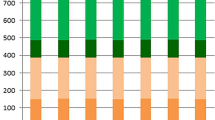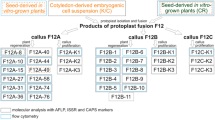Abstract
To study the effect of γ-ray treatment on donor and derived somatic hybrids, we carried out γ-ray donor treatment experiments with a wide range of γ-ray dosages and asymmetric somatic hybridization between protoplasts of wheat (Triticum aestivum L. Jinan 177) and protoplasts of Haynaldia villosa Schur. treated with different dosages of γ-rays (40, 60 and 80 Gy, respectively). We first screened the putative hybrids by isozyme analysis, followed by characterization of nuclear and organellar genome composition of the hybrids. Genomic in situ hybridization on mitotic metaphases demonstrated that the donor chromosome elimination in the hybrids increased with increased γ-ray dosage. Intergenomic chromosome recombination/translocations were observed in the hybrids from different dosages of γ-rays. PCR amplification of 5S rDNA spacer sequences showed that only some of the regenerated hybrid clones inherited donor 5S rDNA sequences, suggesting that the donor DNA was also eliminated randomly. Restriction fragment length polymorphism analysis using mitochondrion (mt) and chloroplast (cp) gene-specific probes showed that the hybrid calli contained mt genomes of both parents and the cp genome of only one of the parents. Recombinations between parental mt as well as cp genes were found in the hybrid clones. Furthermore, development of the hybrid clones was dependent on the γ-ray dosage used for the donor treatment. Regenerated plants were only obtained from fusion combinations of low (40 Gy) and intermediate (60 Gy) dose irradiation. The possible role and significance of γ-rays on the introgression of small segments of donor chromosomes to the receptor is discussed.



Similar content being viewed by others
Abbreviations
- cp:
-
Chloroplast
- GISH:
-
Genomic in situ hybridization
- mt:
-
Mitochondrion
- RFLP:
-
Restriction fragment length polymorphism
- SKD:
-
Shikimic dehydrogenase
References
Buiteveld J, Kassies W, Geels R (1998) Biased chloroplast and mitochondrial transmission in somatic hybrids of Allium ampeloprasum L. and Allium cepa L. Plant Sci 131:219–228
Cardi T, Bastia T, Monti L, Earle ED (1999) Organelle DNA and male fertility variation in Solanum spp. and interspecific somatic hybrids. Theor Appl Genet 99:819–828
Derks FHM, Hakkert JC, Verbeek WHJ, Colijn-Hooymans CM (1992) Genome composition of asymmetric hybrids in relation to the phylogenetic distance between the parents. Nucleus–chloroplast interaction. Theor Appl Genet 84:930–940
Doyle JJ, Doyle JI (1990) Isolation of plant DNA from fresh tissue. Focus 12:13–15
Haider Ali SN, Ramanna MS, Jacobsen E, Visser RGF (2001) Establishment of a complete series of a monosomic tomato chromosome addition lines. Theor Appl Genet 103:687–695
Hyde BB (1953) Addition of individual Haynaldia villosa chromosomes to hexaploid wheat. Am J Bot 40:174-182
Kisaka H, Kisaka M, Kanno A, Kameya T (2001) In:Nagata Bajaj (eds) Somatic hybridization between Hordeum vulgare L. (Barley) and Daucus carota L. (carrot). Biotech Agric For 49:1–16
Leino M, Teixeira R, Landgren M, Glimelius K (2003) Brassica napus lines with rearranged Arabidopsis mitochondria display CMS and a range of developmental aberrations. Theor Appl Genet 106:1156–1163
Li YG, Stoutjeslijk PA, Larkin PJ (1999) Somatic hybridization for plant improvement In: Soh WY Bhojwani SS (eds) Morphogenesis in plant tissue cultures. Kluwer, Dordrecht, pp363–418
Liu DJ, Chen PD, Wang YN, Qiu BX, Wang SL (1988) Transfer of Haynaldia villosa chromosomes into Triticum aestivum. In: Miller TE, Koebner RMD (eds) Proceedings of the 7th International Wheat Genetics Symposium, Cambridge, UK. pp 355–361
Moreira CD, Chase CD, Gmitter FG, Grosser JW (2000) Transmission of organelle genomes in citrus somatic hybrids. Plant Cell Tissue Organ Cult 61:165–168
Parokonny AS, Kenton AY, Gleba YY, Bennett MD (1992) Genome reorganization in Nicotiana asymmetric somatic hybrids analysed by in situ hybridization. Plant J 2:863–874
Rick CM, Fobes JF, Holle M (1997) Genetic variation in Lycopersicon pimpinellifolium: evidence of evolutionary change in mating system. Plant Syst Evol 127:139–170
Schoenmakers HCH, Wolters AMA, de Haan A, Saiedi AK, Koorneeff M (1994) Asymmetric somatic hybridization between tomato (Lycopersicon esculentum Mill) and gamma-irradiated potato (Solanum tuberosum L.): a quantitative analysis. Theor Appl Genet 87:713–720
Shu CQ (1995) Progress in the application of somatic hybridization in plant breeding. Econ For Res 13:69–72
Sigareva MA, Earle ED (1997) Direct transfer of a cold-tolerant Ogura male-sterile cytoplasm into cabbage (Brassica oleracea ssp. capitata) via protoplast fusion. Theor Appl Genet 94:213–220
Spangenberg G, Valles MP, Wang ZY, Montavon P, Nagel J, Potrykus I (1994) Asymmetric somatic hybridization between tall fescue (Festuca arundinaceae Schreb) and irradiated Italian ryegrass (Lolium multiforum Lam) protoplasts. Theor Appl Genet 88:509–519
Wang J, Xiang FN, Xia GM, Chen HM (2004) Transfer of small chromosome fragments of Agropyron elongatum to wheat chromosome via asymmetric somatic hybridization. Sci China Ser C 34:113–120
Wolters AMA, Schoenmakers HCH, Koornneef M (1995) Chloroplast and mitochondrial DNA composition of triploid and tetraploid somatic hybrids between Lycopersicon esculentum and Solanum tuberosum. Theor Appl Genet 90:285–293
Wolters AMA, Schoenmakers HCH, Meuen-Muiisers JJM, van der Knaap E, Derks FHM, Koorneef M, Zelcer A (1991) Limited DNA elimination from irradiated potato parent in fusion products of albino Lycopersicon esculentum. Theor Appl Genet 83:225–232
Xia GM, Chen HM (1996) Plant regeneration from intergeneric somatic hybridization between Triticum aestivum L. and Leymus chinensis (Trin) Tzvel. Plant Sci 120:197–203
Xia GM, Xiang FN, Zhou AF, Wang H, Chen HM (2003) Asymmetric somatic hybridization between wheat (Triticum aestivum L.) and Agropyron elongatum (Host) Nevishi. Theor Appl Genet 107:299–305
Xiang FN, Xia GM, Chen HM (2003) Effect of UV dosage on somatic hybridization between common wheat (Triticum aestivum L.) and Avena sativa L. Plant Sci 164:697–707
Xiang FN, Xia GM, Zhi DY, Wang J, Hui L, Chen HM (2004) Hybrid plant regeneration in relation to the nuclear and cytoplasmic genomes of wheat and Setaria italica. Genome 47:680-688
Zhou AF, Xia GM, Chen HM (1996) Asymmetric somatic hybridization between Triticum aestivum L. and Haynaldia villosa Schur. Sci China Ser C 39:617–629
Zhou AF, Xia GM, Zhang XQ, Chen HM, Hu H (2001) Analysis of chromosomal and organellar DNA of somatic hybrids between Triticum aestiuvm and Haynaldia villosa Schur. Mol Genet Genom 265:387–393
Acknowledgements
The authors wish to thank Dr Spangenberg for kindly providing mitochondria and chloroplast gene clones. The project was supported by the National Natural Science Foundation of China (grant no. 30370857).
Author information
Authors and Affiliations
Corresponding author
Additional information
Communicated by R.J. Rose
Rights and permissions
About this article
Cite this article
Zhou, A., Xia, G. Introgression of the Haynaldia villosa genome into γ-ray-induced asymmetric somatic hybrids of wheat. Plant Cell Rep 24, 289–296 (2005). https://doi.org/10.1007/s00299-005-0922-3
Received:
Revised:
Accepted:
Published:
Issue Date:
DOI: https://doi.org/10.1007/s00299-005-0922-3




